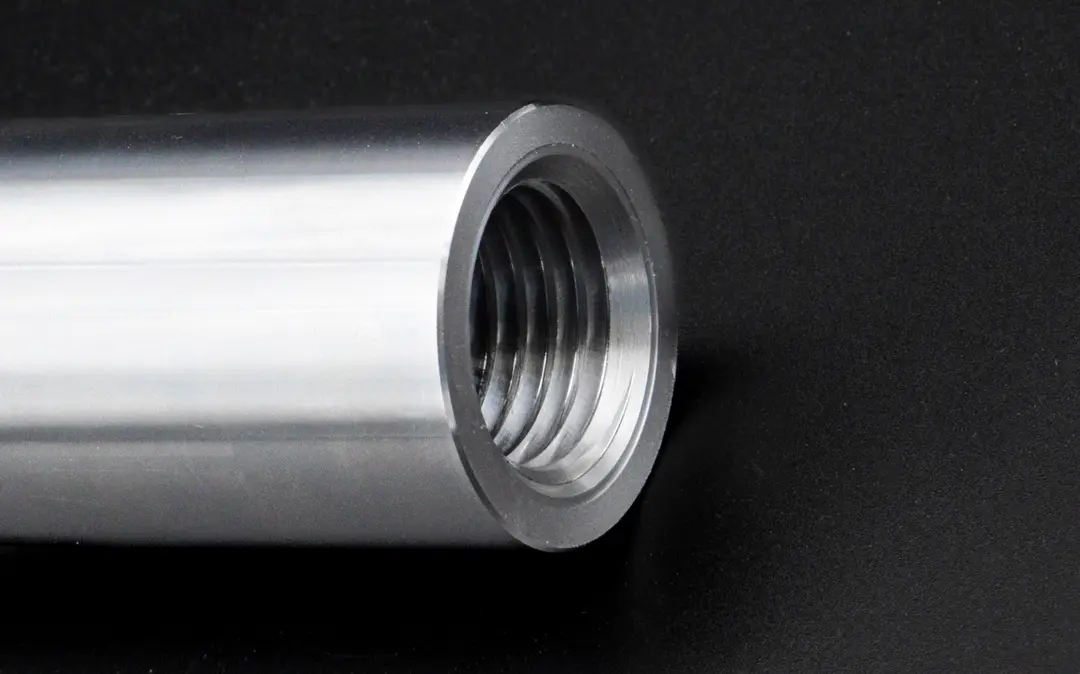 Contact us
Contact us

Thread pitch might seem like a small detail, but getting it wrong can cause serious issues, misaligned parts, poor fits, or even mechanical failure. If you're designing or sourcing precision-machined components, knowing how pitch works is essential for ensuring proper fit and function. This guide is here to walk you through everything you need to know.
You’ll learn what thread pitch is, how different thread types compare, and how to read and use a thread pitch chart effectively. We’ll also show you how to measure thread pitch, avoid common specification mistakes, and select the best pitch for your application. Along the way, you’ll find practical tips, visual references, and links to expert resources for tolerancing and thread callouts.
Want to ask us specific questions about machining threads?
Thread pitch is the distance a fastener travels forward when turned one full rotation. It’s measured along the screw’s axis and represents the space between adjacent thread peaks. This small detail plays a big role in how securely and accurately your components come together.
Picture turning a screw: every full turn moves it forward by the amount of its pitch. Fine threads move shorter distances per turn, offering greater precision and tighter control. Coarse threads move more quickly and are easier to assemble, making them ideal for speed and strength.
More complex thread forms, like trapezoidal or multi-start threads, follow the same basic rule. You may need to visualise or trace the same thread line to measure pitch accurately. Once you understand this movement, thread pitch becomes a powerful tool in your design process.
Thread pitch charts are one of the most useful tools you can have on hand when selecting threads or reviewing technical drawings. They pull together all the key data, diameter, pitch, drill size, and tolerances, into one quick reference. This makes it easier to make fast, accurate decisions during design and production, these charts typically include:
Keeping a standard thread pitch chart nearby during the design process can help prevent common spec errors. It’s one of the easiest ways to check pitch and thread compatibility before the part hits production. You can also cross-check values with CAD software or refer to formal standards for peace of mind.
Note: all dimensions are in mm.'s
O.Dia. Core Pitch Depth Flat Effec. Tapp'g Drill Cl'ance Drill 1.6 1.1706 0.35 0.2147 0.04375 1.373 1.25 1.65 1.8 1.3706 0.35 0.2147 0.04375 1.573 1.45 1.85 2.0 1.5092 0.4 0.2454 0.05000 1.740 1.60 2.05 2.2 1.6480 0.45 0.2760 0.05625 1.908 1.75 2.25 2.5 1.9480 0.45 0.2760 0.05625 2.208 2.05 2.60 3.0 2.3866 0.5 0.3067 0.0625 2.675 2.50 3.10 3.5 2.7638 0.6 0.3681 0.07500 3.110 2.90 3.60 4.0 3.1412 0.7 0.4294 0.0875 3.545 3.30 4.10 4.5 3.5798 0.75 0.4601 0.09375 4.013 3.80 4.60 5.0 4.0184 0.8 0.4908 0.10000 4.480 4.20 5.10 6.0 4.7732 1.0 0.6134 0.12500 5.350 5.00 6.10 7.0 5.7732 1.0 0.6134 0.12500 6.350 6.00 7.20 8.0 6.4664 1.25 0.7668 0.15625 7.188 6.80 8.20 10.0 8.1596 1.5 0.9202 0.18750 9.026 8.50 10.20 12.0 9.8530 1.75 1.0735 0.21875 10.863 10.20 12.20 14.0 11.5462 2.0 1.2269 0.25000 12.701 12.00 14.25 16.0 13.5462 2.0 1.2269 0.25000 14.701 14.00 16.25 18.0 14.9328 2.5 1.5336 0.31250 16.376 15.50 18.25 20.0 16.9328 2.5 1.5336 0.31250 18.376 17.50 20.25 22.0 18.9328 2.5 1.5336 0.31250 20.376 19.50 22.25 24.0 20.3194 3.0 1.8403 0.37500 22.051 21.00 24.25 27.0 23.3194 3.0 1.8403 0.37500 25.051 24.00 27.25 30.0 25.7060 3.5 2.1470 0.43750 27.727 26.50 30.50 33.0 28.7060 3.5 2.1470 0.43750 30.727 29.50 33.50 36.0 31.0924 4.0 2.4538 0.50000 33.402 32.00 36.50 39.0 34.0924 4.0 2.4538 0.50000 36.402 35.00 39.50 42.0 36.4790 4.5 2.7605 0.56250 39.077 37.50 42.50 45.0 39.4790 4.5 2.7605 0.56250 42.077 40.50 45.50 48.0 41.8646 5.0 3.0672 0.62500 44.752 43.00 48.75 52.0 45.8646 5.0 3.0672 0.62500 48.752 47.00 52.75 56.0 49.2522 5.5 3.3739 0.68750 52.428 50.50 56.75 60.0 53.2522 5.5 3.3739 0.68750 56.428 54.50 60.75 64.0 56.6388 6.0 3.6806 0.75000 60.103 58.00 64.75 68.0 60.6388 6.0 3.6806 0.75000 64.103 62.00 68.75
Standardised thread types make it easier to machine, assemble, and replace parts without extra customisation. Whether you're working with metric or imperial threads, understanding the differences in pitch and standard helps you avoid compatibility issues. Here’s a closer look at the most commonly used thread systems and how they compare.
Metric threads are based on millimetres, with pitch included in the size designation (e.g. M10 x 1.5). They’re part of the ISO system and widely adopted in industries like aerospace, medical, and consumer goods. Clear notation and easy measurement make them a favourite for design engineers.
ISO threads are internationally recognised and fall under standards like ISO 68-1 and ISO 261. They support both fine and coarse pitches for general-use fasteners in a wide range of applications. Their global standardisation makes sourcing and manufacturing more efficient.
Fine threads use a smaller pitch, which provides greater control and better resistance to vibration. These are often used where parts need precise adjustment or where the material is thin. Common applications include instrumentation, aerospace fittings, and medical devices.
Coarse threads have a larger pitch and allow faster installation with fewer rotations. They're commonly used in general-purpose applications where strength and speed matter more than precision. Construction, machinery repair, and heavy-duty fixtures often rely on coarse threads.
Getting the pitch right is essential if you want your threads to fit and function properly. Use a pitch gauge to measure the distance between thread peaks, or for imperial threads, divide 25.4 by the TPI to convert to metric. This simple step helps avoid mismatches and supports smoother assembly later on. Common pitfalls include:
Multi-start threads feature more than one thread winding along the shaft, allowing for faster linear travel. You’ll often find them in high-speed applications like power tools or motion systems. To measure correctly, follow the same thread path around, not just the nearest peaks.
When in doubt, always check with reliable resources like our Geometric Dimensioning and Tolerancing Guide. Taking a moment to verify the spec can prevent costly rework or miscommunication. A quick check now can save a lot of frustration later.
A well-written thread callout tells your machinist everything they need to know clearly and without guesswork. It helps ensure your part is machined to spec and that the threads function as intended. Precision here saves time, money, and future troubleshooting.
A complete callout should specify the thread size, pitch, and tolerance class. For example, “M10 x 1.5 – 6g” is a clear, standard designation. If you're unsure, our machining drawing services can help you get it exactly right.
Always indicate how deep the thread should go, full or partial. The fit depends on the tolerance class, and both mating parts need to match. Use a consistent format throughout your drawings to avoid confusion during production.
Thread symbols in your CAD files should follow ISO or ANSI standards. These are recognised across the industry and reduce misinterpretation. For more information, refer to our unilateral vs bilateral tolerance guide.

Thread pitch isn't a one-size-fits-all decision, it needs to suit your part's specific use. Materials, load conditions, and assembly methods all influence the ideal pitch. Choosing the wrong one can lead to poor performance or part failure.
Here’s what to consider:
Fine threads are often chosen in aerospace and precision engineering for their strength and vibration resistance. Coarse threads, on the other hand, are common in field repairs and heavy-duty applications where speed matters. If you're not sure what’s best, our CNC turning services team is happy to help.
Start by locating the nominal thread size, such as M8 or M12, on the chart. Then look across to find whether the coarse or fine pitch is listed for that size. The pitch will be displayed in millimetres alongside its corresponding diameter.
Use a pitch gauge to physically match the threads, or a calliper to measure the distance between two peaks. For imperial threads, divide 25.4 by the threads per inch (TPI) to convert to metric pitch. This helps ensure compatibility across different systems.
With metric threads, simply measure the distance between two adjacent thread peaks in millimetres. For imperial threads, use the formula: 25.4 ÷ TPI to find the pitch. Always confirm if the thread is single-start or multi-start, as this affects the measurement.
Not always, softer materials usually need a coarser pitch to avoid stripping or pull-out. Harder materials may work well with finer threads for better precision and control. It’s important to match pitch to both the material and the functional demands of the part.